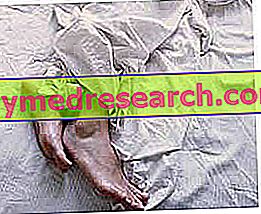Key points
Restless Legs Syndrome (RLS) is a typical neurological sleep disorder: the affected patient perceives the uncontrollable desire to move the lower limbs, the only apparent remedy to find relief and comfort in pain, discomfort and pain in the legs.
Causes

Symptoms
Patients suffering from restless legs syndrome are struggling to define symptoms precisely: nocturnal leg contractions, motor restlessness, uncontrolled leg movements, need to move lower limbs, itching / tickling, tingling in the legs.
Diagnosis
There is no fully reliable diagnostic test to ascertain restless legs syndrome. Generally speaking, the doctor limits himself to analyzing the symptoms according to some standard criteria, drawn up by the National Institutes of Health .
Medications and treatments
- RLS dependent on iron deficiency / Vit. B9-B12 → martial therapy / folate supplementation and / or vitamin B12
- Drug-dependent RLS → modulation of the dosage of the responsible drugs / substitution with other drugs from similar activity
- If restless legs syndrome seriously compromises the quality of sleep → anxiolytic, antiepileptic, antiparkinson, opioid drugs
What is restless leg syndrome?
Restless legs syndrome (or Ekbom syndrome) is a neurological disorder characterized by sensory symptoms and motor disorders in the lower limbs, which occur mainly during rest. For this reason, restless legs syndrome is included in the list of sleep disorders.
Restless legs syndrome is abbreviated as RLS, an acronym for Restless Legs Syndrome : the term was coined around 1940 by a Swedish neurologist, who first described the clinical evidence of the disease accurately.
Restless Legs Syndrome is a subtle onset disease, but responsible for the suffering and discomfort that dramatically weighs on the quality of life of those affected.
The characteristic symptoms associated with restless legs syndrome are rather difficult to define: most patients, in fact, struggle to accurately describe the disorder.
However, it is possible to report three general characteristics that are constantly found in the disease:
- Unpleasant sensitivity disorders in the lower limbs
- Involuntary movements of the legs, sometimes even of the arms
- Impellent need to move the legs: the movement (eg walking, shaking the limbs) gives temporary but immediate relief
As far as treatment is concerned, at the moment no drug is able to completely cancel the disorder; however, therapies are available to alleviate and control symptoms.
Incidence
Restless legs syndrome affects 3-9% of the global population: precise statistical data cannot be reported, since the disorder often remains undiagnosed.
In most cases, the prevalence of the disease increases with age: in fact, the characteristic symptoms of restless legs begin after the age of 40, and become more and more marked with the inexorable passage of time. Despite what has been said, about a third of affected patients complain of the first symptoms already around the age of 20.
Restless legs syndrome is an almost exclusive discomfort of the female sex, which affects many women during pregnancy.
Classification
There are two variants of restless legs syndrome:- Primitive form (idiopathic): generally slow onset, the primitive variant of restless leg syndrome is generally not related to any specific and identifiable cause. The characteristic symptoms can be hidden for months or years, and tend to worsen with aging. The primary form of RLS is believed to be genetically transmitted through an autosomal dominant mechanism.
- Secondary form: typical of patients over 40, the secondary form of restless legs syndrome is the expression of particular clinical conditions *, or is the consequence of a particular pharmacological therapy. Onset is not as slow as the primitive variant: normally, secondary RLS occurs suddenly, and the affected person often complains of the characteristic symptoms even during daylight hours.
Causes *
Before listing the possible causes and the risk factors associated with restless legs syndrome, let us remember that over 60% of sufferers are genetically predisposed to the syndrome.
As analyzed, it is not possible to trace the root cause of the RLS: it is in fact the subtle variant of the disease, with a slow course, which tends to worsen with age.
Different speech for secondary form: in this case, restless legs syndrome appears to be related to some pathologies. In particular, it appears that iron deficiency (ferritin in the blood <20 micrograms per liter) and peripheral neuropathy play a major role in triggering restless leg syndrome.
Why is iron deficiency predisposes a subject to restless legs syndrome?
Iron is the essential cofactor for the formation of L-dopa, a dopamine precursor. Dopamine is a substance responsible for the transmission of messages contained in brain districts, which in turn control movement and coordination. Iron deficiency prevents the correct synthesis of L-dopa: this explains the reason why iron deficiency predisposes a patient to restless legs syndrome.
However, additional diseases involved in the RLS event were also identified:
- Amyloidosis
- Rheumatoid arthritis
- Celiac disease
- Diabetes mellitus
- Lack of folates, magnesium and vitamin B 12
- Autoimmune disorders (eg Sjögren's syndrome)
- Venous insufficiency
- Frequent blood donations
- Thyroid disease
- Lyme disease
- End-stage renal diseases (Renal insufficiency): it is observed that 25-50% of patients suffering from end-stage renal diseases, especially in hemodialysis, are also affected by restless legs syndrome. In similar situations, kidney transplantation can alleviate symptoms, greatly improving the patient's clinical picture.
- Parkinson's disease
- Spinal disorders (eg lumbosacral radiculopathy)
- Uremia
Risk factors
Some factors predisposing to restless legs syndrome have been identified:
- Pregnancy: restless legs syndrome affects 25-40% of pregnant women. This is a temporary disorder, which tends to regress a few weeks after delivery. However, the scientific evidence shows that women affected during pregnancy by RLS are 4 times more at risk of re-developing the disorder during senescence, compared to mothers not affected by the syndrome during gestation.
- Long-term therapy with specific drugs: even the administration of some medicinal products can predispose the patient to restless legs syndrome. If the patient is already affected by the disease, the administration of the following active ingredients may exacerbate the symptoms.
- Anticonvulsants
- Tricyclic antidepressants
- Antidopaminergics (eg neuroleptics, antiemetics)
- Anti-histamines
- Beta blockers (medicines for the treatment of hypertension)
- Lithium derivatives (used, for example, for the treatment of Graves' disease - Basedow)
- Diphenhydramine (hypnotic / sedative)
- Serotonin reuptake inhibitors (second generation antidepressants)
Opioid withdrawal may also be a trigger for RLS.
Furthermore, it seems that an abuse of caffeinated foods and alcohol can predispose a person to restless legs syndrome.



